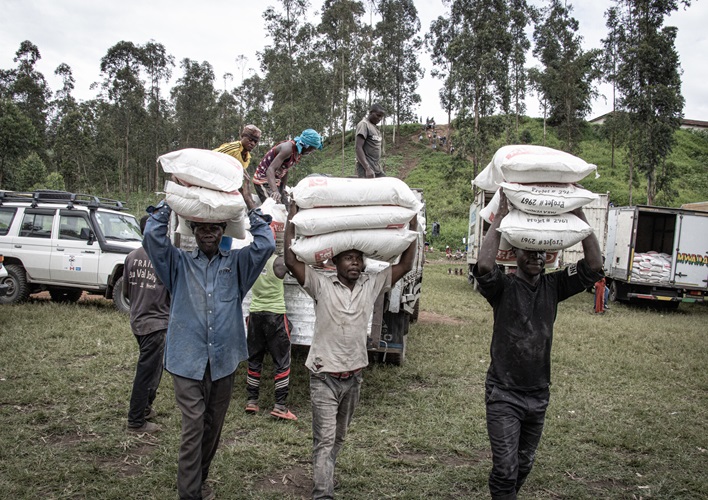Right now, many people are looking at the war in Ukraine, the effects of which have rippled around the globe. Here in Canada, the price at the pumps and the cost of food are steadily climbing – a little reminder to us of the high cost of war.
In the last 10 years, there has also been armed conflict or violence in several other countries including South Sudan, Myanmar, Haiti, Colombia and Somalia.
Before the war in Ukraine, global hunger was already at critical levels. In 2021, 72 percent of the 193 million people experiencing acute hunger and needing food assistance were in 24 countries where conflict was the major driver of hunger.

Thousands of people from South Sudan, after spending years as refugees, are returning home and trying to rebuild. Foodgrains Bank member The Primate’s World Relief and Development Fund is working through their locally-based partner Finn Church Aid to support these families’ efforts. (Photo: Florence Nduku)
Armed conflict is the leading cause of today’s soaring global hunger crisis. Last year, Foodgrains Bank members responded to conflict through 33 projects totalling $27.1 million.
Over 385 days in Ukraine.
Over seven years in Yemen.
Over a decade in Syria.
Conflict causes hunger both directly and indirectly.
Conflict directly causes hunger by disrupting access to, and availability, of food. When conflict or violence breaks out, those in the vicinity can no longer safely move around to get food. For many, the insecurity also means no income to buy food, which may already be in short supply. Farmers will not be able to safely grow and harvest food or keep livestock.
When Abdirashid was 26 months old, he had a high fever and began rapidly losing weight. “We really had nothing to feed him,” shared his mother Nimco. The Somali family had lost their farm and livelihood because of conflicts and a devastating drought. “I could see how he became skinnier and weaker,” said Nimco, remembering the suffering of her middle child. “I was frustrated on what to do next. Nothing seemed to work.”
Conflict is also a direct cause of hunger when fighting parties refuse to allow the safe delivery of food assistance to those in need. For example, in Yemen, the different parties in the conflict have reportedly denied food to get the population to surrender, or diverted humanitarian food assistance. In May 2018, the UN Security Council adopted a resolution that threatened sanctions for those guilty of starving civilians in war.
Famine is the extreme case of hunger. By the time a famine is declared, people are already dying, but humanitarian response can save the people still at risk. Since 2010, there have been two famines in conflict-affected countries. First in Somalia in 2011, then in South Sudan in 2017. There is a global system to warn when there is a risk of famine in a region. Since 2017 several regions have approached famine, but early response by humanitarian agencies has enabled the delivery of food assistance so actual famine was avoided.
Conflict also causes hunger indirectly. The war in Ukraine provides a clear example of this. The indirect impacts of the war have shaken a global economy significantly supplied by grain, fertilizer and energy exports from Ukraine and Russia. Food prices around the world are going up, tied to the rising price of grain and energy, and concerns that the rising price of fertilizer will reduce food production.

Refugees from Ukraine received support from ADRA, a member of the Foodgrains Bank. (Photo: Submitted)
Imagine you regularly had less than a third of your budget to feed your family. Should everyone eat less? Should you sacrifice quality or nutrition and buy the cheapest food? Should the adults skip some meals so the children can eat more? Do you go into debt, just for enough food? These are the hard questions that people are grappling with in this hunger crisis.
Not responding quickly and generously to the global hunger crisis will cost us. In the short term, people will go hungry, they will be more prone to disease because they will be malnourished, and some will starve to death. In the medium to long term, some may experience famine, even more will die, and the hungry children who survive will face a dimmer future.
If we choose to let people go hungry today, we’ve chosen a bleaker future for the next generation. But we can choose to make a difference. In Somalia, Abdirashid was admitted into a program supported by the Foodgrains Bank. Run by Development and Peace’s partner Trócaire, the two year-old boy received ten weeks of treatment that included medication and therapeutic food supplements. Two weeks after leaving the health centre, Nimco shared that “Abdirashid has no problem now and is happily playing.”
As we give more to save more lives today, we must also advocate for peace and do all that we can to end the conflicts that are forcing people into hunger faster than we can feed them.
Learn more about conflict and hunger through Forced to Flee, our interactive resource you can download here.
This story was originally published in the 2023 Spring edition of Breaking Bread. Download or order your copy here.




